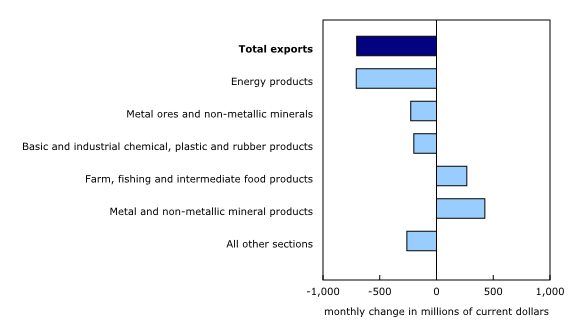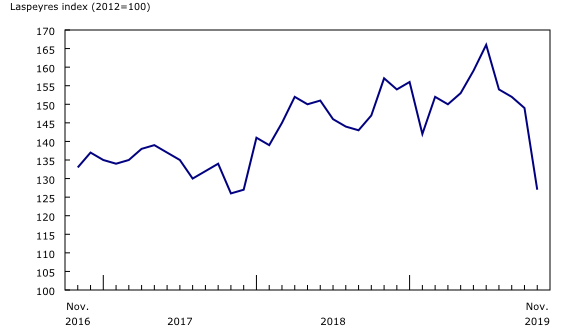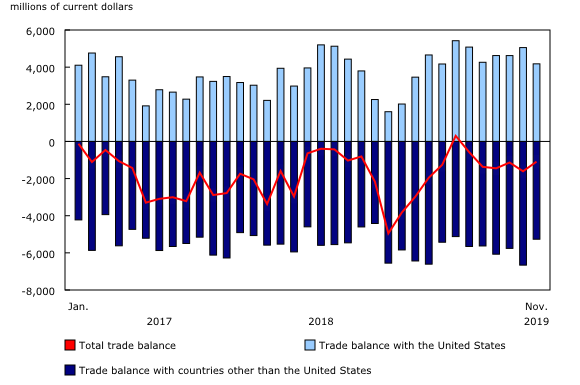Canadian international merchandise trade, November 2019
Archived Content
Information identified as archived is provided for reference, research or recordkeeping purposes. It is not subject to the Government of Canada Web Standards and has not been altered or updated since it was archived. Please "contact us" to request a format other than those available.
Released: 2020-01-07
Canada's merchandise exports declined 1.4% in November to $48.7 billion, while imports were down 2.4% to $49.8 billion. As a result, Canada's merchandise trade deficit with the world narrowed from $1.6 billion in October to $1.1 billion in November.
Widespread declines across export and import products coincided with disruptions in Canadian rail transportation. Customs basis data for November (not seasonally adjusted) showed a stronger decline in trade by rail compared with data for the same month in recent years. This was particularly true for exports, where the 2019 figure was the lowest November value since 2013. Rail is also an important mode for inland shipment within Canada for goods arriving or exiting by other modes of transportation.
Large increases moderate decline in exports
After decreasing 0.4% in October, exports fell a further 1.4% in November. Declines were observed in 7 of 11 product sections, while non-energy exports were essentially unchanged. Compared with the same period in 2018, total exports were up 1.5% in the first 11 months in 2019. In real (or volume) terms, exports were down 2.7% in November from the previous month.
Energy products drove the overall export decrease, down 7.4% on lower exports of crude oil. Export volumes were behind the crude oil decline in November, a month that was marked by disruptions in crude oil pipeline transportation following a rupture that occurred in late October. Partially offsetting this decrease were higher exports of natural gas (+30.7%). Export prices for natural gas rose sharply in November, the third consecutive monthly increase since a low observed in August.
Partially offsetting the overall export decrease were higher exports of metal and non-metallic mineral products (+7.3%), which reached a record in November. Exports of unfinished precious metal products (+29.5%) rose sharply for a second consecutive month, with an increase in exports of gold bars to the United Kingdom and Hong Kong driving the gain. Lower exports of aluminum and iron and steel products helped to moderate the increase for the product section. These products were particularly affected by the rail transportation disruptions in November.
There were also higher exports of farm, fishing and intermediate food products (+9.6%) in November. Following significant declines in October, both canola and other crop products (mainly soybeans) rebounded in November, primarily on higher exports to European destinations. China has been an important recipient of these products in recent years, and after falling sharply in October, exports of canola and soybeans to China failed to rebound in November.
Widespread decreases in imports
Total imports fell 2.4% in November after rising 0.6% in October. Widespread decreases were observed, with 10 of 11 product sections posting declines. Total imports through the first 11 months of 2019 were up 1.4% compared with the same period in 2018. In real (or volume) terms, imports decreased 1.3% in November from the previous month.
Leading the decreases in November were imports of aircraft and other transportation equipment and parts (-13.8%). There were lower imports of airliners from overseas, as well as lower imports of aircraft engines and parts from the United States. Lower imports of railcars also contributed to the decline in November, mainly on decreased imports of tank cars for the transportation of crude oil.
Imports of energy products declined 7.5% in November, mainly due to lower import volumes of natural gas. Despite the November decrease, year-to-date import values for natural gas were up 7.2% compared with the same period in 2018. Lower imports of crude oil also contributed to the November decline in energy products as a result of a decline in prices.
Exports to the United States drop
Exports to the United States decreased 3.3%, while imports fell 1.1%. As a result, Canada's trade surplus with the United States narrowed from $5.1 billion in October to $4.2 billion in November, the smallest surplus since April. When the average exchange rates of October and November are compared, the Canadian dollar lost 0.3 US cents relative to the American dollar.
Exports to countries other than the United States rose 4.3% in November. There were record exports to the United Kingdom (gold and crude oil), as well as increased exports to France (canola and soybeans) and Hong Kong (gold).
Imports from countries other than the United States fell 4.7%, led by lower imports from China (various products) and Mexico (autos).
As a result, Canada's trade deficit with countries other than the United States narrowed from $6.7 billion in October to $5.3 billion in November.
Revisions to October merchandise exports and imports
Revisions reflect initial estimates being updated with or replaced by administrative and survey data as they become available, as well as amendments made for late documentation of high-value transactions. Imports in October, originally reported as $51.0 billion in the previous release, were essentially unchanged in the current month's release. Exports in October, originally reported as $49.9 billion in the previous release, were revised to $49.4 billion.
In the previous release, significant exports of fine art pieces being shipped on consignment were included in the international merchandise trade statistics for October. With additional imports and exports of this type occurring in November, Statistics Canada has determined that going forward only the portion of these shipments that are ultimately sold will be included in balance of payments basis statistics. In the current release, export statistics for October have been revised accordingly, and November imports and exports reflect only the pieces that were sold.
Monthly trade in services
Monthly exports of services edged up 0.1% in November to $11.5 billion. Imports of services rose 1.0% to $13.0 billion.
Combining international trade in goods and services, exports in November declined 1.1% to $60.2 billion and imports were down 1.7% to $62.8 billion. As a result, Canada's trade deficit with the world for goods and services combined was $2.6 billion in November.
For more information on monthly trade in services, please consult today's Daily release, "Canadian international trade in services."
Note to readers
Merchandise trade is one component of Canada's international balance of payments (BOP), which also includes trade in services, investment income, current transfers, and capital and financial flows.
International trade data by commodity are available on both a BOP and a customs basis. International trade data by country are available on a customs basis for all countries and on a BOP basis for Canada's 27 principal trading partners (PTPs). The list of PTPs is based on their annual share of total merchandise trade—imports and exports—with Canada in 2012. BOP data are derived from customs data by making adjustments for factors such as valuation, coverage, timing and residency. These adjustments are made to conform to the concepts and definitions of the Canadian System of National Accounts.
For a conceptual analysis of BOP versus customs-based data, see "Balance of Payments trade in goods at Statistics Canada: Expanding geographic detail to 27 principal trading partners."
For more information on these and other macroeconomic concepts, see the Methodological Guide: Canadian System of Macroeconomic Accounts (13-607-X) and the User Guide: Canadian System of Macroeconomic Accounts (13-606-G).
Data in this release are on a BOP basis and are seasonally adjusted. Unless otherwise stated, values are expressed in nominal terms, or current dollars. References to prices are based on aggregate Paasche (current-weighted) price indexes (2012=100). Volumes, or constant dollars, are calculated using the Laspeyres formula (2012=100).
For information on seasonal adjustment, see "Seasonally adjusted data – Frequently asked questions."
Revisions
In general, merchandise trade data are revised on an ongoing basis for each month of the current year. Current-year revisions are reflected in both the customs and BOP-based data.
The previous year's customs-based data are revised with the release of the January and February reference months, and thereafter on a quarterly basis. The previous two years of customs-based data are revised annually, and revisions are released in February with the December reference month.
The previous year's BOP-based data are revised with the release of data for the January, February, March and April reference months. To remain consistent with the Canadian System of Macroeconomic Accounts, revisions to BOP-based data for previous years are released annually in December with the October reference month.
Factors influencing revisions include the late receipt of import and export documentation, incorrect information on customs forms, replacement of estimates produced for the energy section with actual figures, changes in classification of merchandise based on more current information, and changes to seasonal adjustment factors.
For information on data revisions for crude oil and natural gas, see "Revisions to trade data for crude oil and natural gas."
Revised data are available in the appropriate tables.
Real-time data table
Real-time table 12-10-0120-01 will be updated on January 20, 2020.
Next release
Data on Canadian international merchandise trade for December 2019 will be released on February 5, 2020.
Products
The product "International Trade Explorer" (71-607-X) is now available online. This product provides a new way of looking at Canada's trade relations. Leveraging the analytical richness of customs data, this product offers four different visualization tools: an interactive world map, a tree map, a stacked bar chart and a visualization tool for trade by province.
Customs-based data are now available in the Canadian International Merchandise Trade Database (65F0013X).
The updated Canada and the World Statistics Hub (13-609-X) is now available online. This product illustrates the nature and extent of Canada's economic and financial relationship with the world using interactive graphs and tables. This product provides easy access to information on trade, investment, employment and travel between Canada and a number of countries, including the United States, the United Kingdom, Mexico, China, Japan, Belgium, Italy, the Netherlands, and Spain.
Contact information
For more information, contact us (toll-free 1-800-263-1136; 514-283-8300; STATCAN.infostats-infostats.STATCAN@canada.ca). To enquire about the concepts, methods or data quality of this release, contact Benoît Carrière (613-415-5305; benoit.carriere@canada.ca), International Accounts and Trade Division.
- Date modified:









